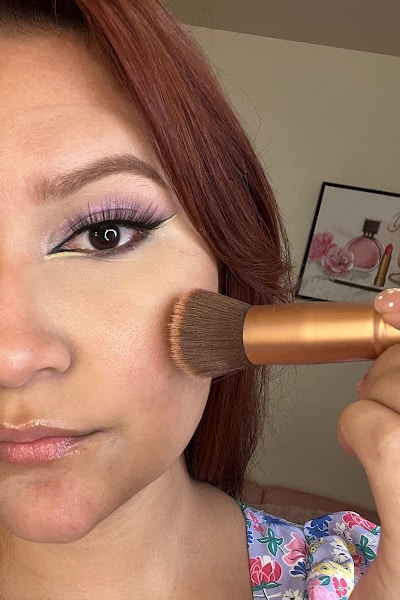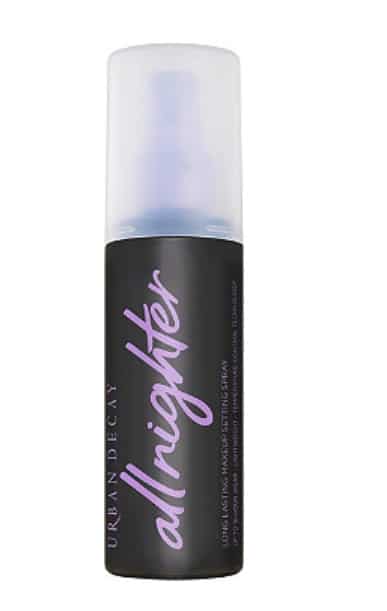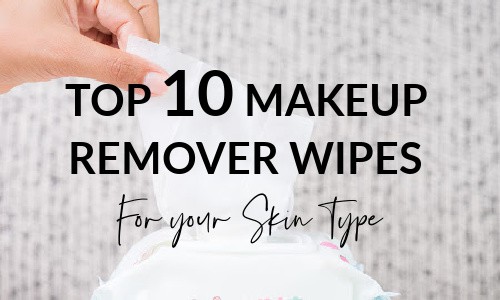Hey there! Do you ever feel like your foundation isn’t doing its job and leaving your skin looking patchy and uneven?
Don’t worry, you’re not alone!
In this post, I’m going to share some tips and tricks for fixing a patchy foundation and achieving a smooth and flawless finish.
so wether you have experience a patchy foundation before and you want to know how to prevent your foundation from looking patching again, or you are experiencing a patchy foundation in this exact moment,
in this post, we will share what you can do to fix it in minutes.
This post may contain affiliate links. That means if you click and buy, I may receive a small commission (at zero cost to you). Please see my full disclosure policy for details.
Patchy Foundation right now? Easy fix for patchy foundation
If you are experiencing patchy foundation right now (and you have your makeup bag on hand and access to a restroom) I want you to completely remove your makeup on the area of the patchiness.
If this is your entire face, wash your face.
A common mistake you want to avoid is to apply ANY makeup product (name powders, creams or liquids) on top of the patchiness “to fix it”. don’t do that. This is not a fix, it will make a bigger mess.
I know some recommend to apply certain type of face powder (powder foundation, mattifying powder, setting powder) on top of the patch to fix it.
I do not recommend this.
The next thing I want you to do, is dry the area and restart your makeup routine in that specific affected area.
It all depends on the type of foundation that you are using, if I assume that is a liquid foundation,
apply your primer, then your foundation and once it’s dry apply a setting powder like this one (not a powder foundation!! , more on that below)
and it doesn’t necessarily need to be a pricey one, if you are on a budget, this setting powder here is a GREAT affordable option that does the job.
If you do not have access to a restroom to wash your face…
Or if you simply don’t want to remove your makeup at this moment, you need to try blotting papers.
My top recommendation is the rice paper oil-absorbing tissues here.
Even if you have dry skin and you don’t feel like you have oil to fix with the papers, this step is important.
You want to absorb the excess product, natural oils, etc before adding ANY makeup product on top.
So doing this is a must.
After that, you can either reapply a tiny, lightweight layer of your foundation again only in that AFFECTED area.
After that, apply a setting and blotting powder WITHOUT COLOR like this one by Fenty beauty.
-> We don’t want to add more unnecessary layers of products to our skin because it will get patchy again.
Identify the Cause
Before we dive into the solutions, it’s important to identify the cause of your patchy foundation.
Dehydrated Dry skin, excessively oily skin, the wrong foundation type, and improper application are all common causes.
By identifying the cause, you can choose the best solution for your particular issue.
Solutions for Patchy Foundation

The solutions for patchy foundation can vary depending on the cause, but here are some general tips that should help:
Exfoliate and moisturize your skin:
Exfoliating will remove dead skin cells that can cause a foundation to look patchy. Moisturizing will ensure that your skin is hydrated and prepped for foundation.
Exfoliating is a crucial step in preventing patchy foundation.
When you exfoliate your skin, you remove dead skin cells that can cause your foundation to look uneven or patchy. However, it’s important to exfoliate properly to avoid damaging your skin.
Here are some tips for properly exfoliating:
Choose the right exfoliator for your skin type: There are two main types of exfoliators – physical and chemical.
Physical exfoliators use scrubbing particles to physically remove dead skin cells, while chemical exfoliators use acids to dissolve dead skin cells.
If you have sensitive skin, a chemical exfoliator may be a better option for you.
This one here is a good exfoliator.
2. Exfoliate gently:
When exfoliating, be gentle with your skin.
Don’t scrub too hard or use too much pressure, as this can cause irritation and damage to your skin.
Instead, use a light touch and let the exfoliator do the work.
Don’t overdo it: Exfoliating too often can also cause damage to your skin.
Depending on your skin type, you may only need to exfoliate once or twice a week.
If you notice any redness or irritation after exfoliating, take a break for a few days and then resume with a gentler approach.
3. Moisturize after exfoliating: Exfoliating can be drying to your skin, so it’s important to moisturize after you exfoliate.
This will help to hydrate and soothe your skin, and will also prepare your skin for foundation application.
By properly exfoliating, you can ensure that your skin is smooth and free of dead skin cells, which will help your foundation look more even and natural.
Make sure to choose the right exfoliator for your skin type, exfoliate gently, avoid over-exfoliating, and moisturize after exfoliating to achieve the best results.
Related: The definitive guide on how to make your makeup look smooth and NOT CAKEY
Using the right Primer
Using a primer is a great way to create a smooth base for your foundation, which can help to prevent patchiness and uneven application.
However, it’s important to choose the right primer for your skin type and concerns.
Here are some tips for choosing the right primer:
Consider your skin type: Different primers are designed to work best with different skin types.
If you have oily skin, look for a mattifying primer that will help to control oil and prevent shine.
If you have dry skin, look for a hydrating primer that will provide extra moisture and help to smooth dry patches.
If you have combination skin, look for a primer that will help to balance both oily and dry areas.
Choose a primer that addresses your specific concerns:
In addition to your skin type, you may also have other concerns that you want to address with your primer.
For example, if you have large pores, look for a primer that will help to minimize their appearance. If you have redness or discoloration, look for a primer with color-correcting properties.
Look for a primer with a texture that works for you:
Primers come in various textures, from lightweight gels to creamy formulas.
Experiment with different textures to find the one that works best for your skin type and foundation formula.
Consider the ingredients:
Look for a primer that contains ingredients that will benefit your skin, such as antioxidants or SPF.
Avoid primers that contain irritants, such as alcohol or fragrances, which can cause your skin to react.
By choosing the right primer, you can create a smooth and even base for your foundation that will help to prevent patchiness and uneven application.
Make sure to consider your skin type, specific concerns, texture preferences, and ingredients when selecting a primer to achieve the best results.
Related: The best primers to blur fine lines and wrinkles!
Color correcting the right way to prevent patchy foundation

Color correcting is a technique used to neutralize certain colors on your skin, such as redness or dark circles, using opposite colors on the color wheel.
By using a color corrector before applying foundation, you can create a more even base and prevent the need for layering on too much foundation, which can lead to patchiness.
Here are some tips for using color correctors to fix or prevent patchy foundation:
Choose the right color corrector:
To use color correctors effectively, you need to choose the right color for the issue you want to correct.
For example, green correctors are great for neutralizing redness, while peach or orange correctors work well for dark circles. Make sure to choose a color that is opposite on the color wheel to the color you want to neutralize.
Apply color corrector before foundation:
After you’ve moisturized and primed your skin, apply the color corrector to the areas where you need it.
Use a small brush or your fingers to blend the corrector into your skin, and then let it sit for a few seconds to settle in.
Apply foundation sparingly:
After you’ve applied the color corrector, you should only need a small amount of foundation to achieve an even, natural look.
Use a beauty blender or a brush to apply the foundation in thin layers, building up coverage as needed.
By using less foundation, you can prevent it from getting patchy and help it last longer throughout the day.
Color correcting can be a game-changer for those who struggle with patchy foundation.
By neutralizing any discoloration on your skin, you can create a smooth and even base that doesn’t require a lot of foundation to cover up.
Just make sure to choose the right color corrector, apply it before your foundation, and use foundation sparingly to achieve the best results.
Related: How to use the Color wheel for Makeup: A helpful guide
Apply Setting Spray to prevent Patchy foundation from happening Again

Setting spray is a great way to lock in your makeup and prevent it from getting patchy or fading throughout the day.
It creates a thin, invisible layer over your makeup that helps to hold everything in place, and also adds a subtle glow or matte finish depending on the formula you choose. This one here is our #1 Favorite Setting spray of all time
Here are some tips for using a setting spray to prevent patchy foundation:
Choose the right setting spray:
Just like with primers and color correctors, different setting sprays are designed to work best with different skin types and concerns.
If you have oily skin, look for a mattifying setting spray like this one that will help to control oil and prevent shine.
If you have dry skin, look for a hydrating setting spray like this one here that will provide extra moisture and prevent your makeup from looking cakey or flaky.
Apply setting spray after your makeup:
Once you’ve applied your foundation, concealer, and any other makeup product, hold the setting spray about six inches away from your face and mist it all over.
Make sure to close your eyes and mouth to avoid getting the spray in them.
Let it dry
After applying the setting spray, let it dry completely before touching your face or applying any additional makeup.
This will help to ensure that the spray sets your makeup in place and prevents patchiness.
Additional makeup? Yes I recommend to apply setting powder AFTER setting spray.
Using setting spray is a great way to keep your makeup looking fresh and prevent it from getting patchy throughout the day.
By choosing the right formula, applying it after your makeup, and letting it dry completely, you can ensure that your foundation stays in place and looks flawless all day long.
Still getting patchy foundation even when you apply setting spray?
It might be that your setting spray contains alcohol that dry out and/or mix with the foundation in a wrong way that it actually breaks the makeup to make it look patchy.
It may sound weird, but if you have tried EVERYTHING without success, it might be your setting spray.
Skip setting spray for one day and see what happens after 4 and 8 hours and compare it for when you apply setting spray.
Setting powder – APPLY IT THE RIGHT WAY!
Setting powder is a powder ( Different from a regular pressed or loose powder) that is used to set your makeup and help it last longer.
It is typically applied after foundation and concealer to create a smooth, matte finish and prevent any oiliness or shine from coming through.
But there are also setting powders with hydrating ingredients for a more satin/dewy finish.
How to use setting powder to prevent patchy foundation:

Choose the right setting powder.
Powder foundation is NOT setting powder.
The best setting powder is TRANSLUCENT.
And will not add more layers of color to the makeup. It will only set it in place.
There are many different types of setting powder available, each with its own unique formula and finish.
If you have dry skin, choose a finely-milled, hydrating powder that won’t settle into fine lines or make your skin look cakey. like this one here.
If you have oily skin, choose a powder that is oil-absorbing and mattifying to prevent shine and control oil like this Palladio rice powder.
Powder foundation and pressed powders with color are for ANOTHER USE.
You can check my guide on how to apply powder foundation correctly without looking “powdery” or drying the skin.
Apply setting powder with a brush or sponge
After you’ve applied your foundation and concealer, use a powder brush or makeup sponge to apply a thin layer of setting powder over your face.
Be sure to blend the powder thoroughly to prevent any patchiness or unevenness.
Focus on areas that tend to get oily: If you have oily skin or tend to get shiny throughout the day, focus on applying extra powder to your T-zone (forehead, nose, and chin) to prevent any oiliness from coming through.
Use a light hand
When applying setting powder, it’s essential to use a light hand and not apply too much.
SAY GOODBYE TO THE BAKING TECHNIQUE.
Overloading your skin with powder can make your foundation look cakey and settle into fine lines or wrinkles, leading to patchiness.
Using setting powder is a great way to prevent patchy foundation and help your makeup last longer throughout the day.
By choosing the right powder for your skin type, applying it with a brush or sponge, focusing on oily areas, and using a light hand, you can achieve a flawless, long-lasting finish that looks natural and smooth.
If want to read more about why your foundation gets patchy, flaky or CAKEY check this article where I talk about the 10 reasons why your foundation get CAKEY and how to fix it!
Conclusion on how to fix patchy foundation
So there you have it!
You can achieve a smooth and flawless finish by identifying the cause of your patchy foundation and using these tips and tricks.
Remember, it may take some experimentation to find the right solution for your skin type and concerns, but with a little patience and practice, you can achieve the flawless foundation you desire.
Good luck, makeup friend!
–> Don’t forget to get your FREE Makeup guide for beginners ebook by clicking the button below.


